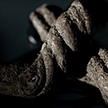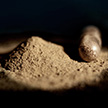History
The relationship between the human species and plants capable of altering body and mind is millenarian. People have developed a harmonic relationship with these plants, and frequently they have had a great influence in the human and cultural development of many societies and civilizations.
The use of ayahuasca originates from the Amazon region in countries including Colombia, Brazil, Peru and Ecuador. For centuries, indigenous peoples have utilized this botanical mixture in their rituals for healing or divination, as well as other activities such as witchcraft and warfare. It is known that at least one of the plants used in the ayahuasca preparation has been used for millennia. This plant, known by the botanical name Banisteriopsis caapi, is a vine that grows in the entire Amazon and has been used by numerous cultures for its emetic effects and other somatic symptoms. The main botanical species this plant is combined with are the bush Psychotria viridis (Chacruna) and Diplopterys cabrerana (Chacropanga), but many admixtures are used in traditional recipes, such as tobacco, varieties of Brugmansia, Brunfelsia, etc.
Extension of its use
Ayahuasca has been traditionally used by many ethnic groups such as the Shuar in Ecuador or the Shipibo-Conibo in Peru, who continue using ayahuasca, as well as many other plants, for medicinal and divinatory purposes today. Ayahuasca has a central role in these cultures’ world views.
The widespread use of ayahuasca is not restricted to the indigenous peoples of the Amazon; it can also be found in the mestizo populations in the rural and urban areas of countries such as Colombia, Peru and Brazil. In such places, ayahuasca is used for the purpose of healing and other ritualistic activities, where the boundaries that divide indigenous traditions from elements of other cultures often are blurred.
Approximately eighty years ago, non-indigenous groups who incorporated the use of Ayahuasca into their religious rituals began appearing in Brazilian cities in the Acre and Rondônia State. Santo Daime, União do Vegetal, and Barquinha are the most representative religions that first appeared in the Brazilian Amazonian cities and later expanded across the main Brazilian cities as well as Europe, the United States and Asia. The religious use of Ayahuasca by these groups is characteristically syncretic, where elements from Christianity, afro-Brazilian religiosity and indigenous shamanism are blended together.
In the fifties, awareness of the existence of ayahuasca spread to western civilization. The publication of “The Yagé Letters”, which contained the letters William Burroughs and Allen Ginsberg shared about their personal experiences with ayahuasca, as well as the research conducted by Richard Evans Schultes, all played a crucial role in bridging these worlds. Since then, the use of ayahuasca started to spread into occidental culture slowly, and new contexts of use appeared, such as the use in psychotherapy and personal growth.
Today, the use of ayahuasca has globalized significantly and is being integrated more and more into contemporary contexts.
Use
Due to the global expansion of ayahuasca, there are a large and growing variety of groups that use ayahuasca for different purposes, principally those of religious, psychotherapeutic, personal growth and healing.
The religious use of ayahuasca by the ayahuasca-churches is syncretic, meaning that they blend elements of different spiritual schools, such as Christianity, Afro-Brazilian religious practices and indigenous shamanism.
In Europe and North America, the use of ayahuasca has spread among people who approach it as a tool for personal growth and self-development. Others travel to Amazonian countries such as Brazil, Peru or Colombia to experience ayahuasca in the traditional ritual context, or in centers that offer different programs which incorporate the use ayahuasca. There are also sessions organized by native shamans in Europe and the US, among others.
It should be emphasized that the use of ayahuasca is becoming increasingly relevant in psychotherapy conducted by western therapists and guides. In this context, the ingestion of ayahuasca, usually in group settings, has therapeutic purposes and is accompanied by a process of preparation and integration of the experience based on psychotherapeutic methods. These groups are usually focused on personal development and the deepening of the therapeutic process, as well as recovery from specific processes such as depression, mourning, addiction, etc.
Other groups combine elements of western psychotherapy within the context of the ayahuasca session itself, creating ‘neo-shamanic’ ritual contexts that usually include elements from eastern philosophies. These groups are usually organized by people that have been in contact with ayahuasca as well as other self-development tools, such as meditation and yoga.
It is clear that the use of ayahuasca has globalized and the contexts and purposes of use are as diverse as the people and groups that use it.
Effects
Ayahuasca is taken orally. The taste is generally described as being intense and unpleasant, which marks the beginning of the physical change that ayahuasca provokes. In about 15-60 minutes, the ayahuasca induces an altered state of consciousness, in which the person frequently experiences highly emotionally charged visions. The experience can bring up recollections and images of one’s past. Repressed memories can also come to the surface. Individuals can work with this material, restructuring related thoughts and emotions and integrating them in their current way of living life. The experience can also include archetypal, transpersonal, mystical and perinatal content.
The effects of ayahuasca are emetic, frequently causing vomiting and diarrhea, which is interpreted by the shamans and other providers of sessions as what is called the ‘purga’: an emotional and physical cleanse. The principal effects of ayahuasca wear off after approximately 2 - 4 hours after ingestion, although they can become prolonged if there are several administrations. Once the effects subside, they make space for residual effects of fatigue and introspection. From the physiological point of view, ayahuasca moderately increases the heart rate.
Safety
The effects of ayahuasca in humans have not been studied in their entirety, which underscores the need for more clinical research and follow up studies. Present scientific research indicates that the use of ayahuasca by healthy individuals is relatively safe from the physiological health perspective. However, it should be taken into account that no clinical trials have been done in relation to the safety profile of ayahuasca in people who suffer health problems. For example, it is demonstrated that the effect of ayahuasca on the cardiovascular system is moderate in young, healthy individuals, but older subjects with heart problems might experience a different reaction. Therefore, these cases should be treated with caution.
Physical safety
The alkaloids present in ayahuasca interact with the serotonergic system in different ways: the beta-carbolines, for example harmine, are inhibitors of the MAO enzyme, which has its role in the degradation of serotonin and other neurotransmitters. Therefore, the use of ayahuasca in combination with other serotonergic pharmaceuticals, such as antidepressants, can potentially cause adverse reactions such as the ‘serotonin syndrome’, which theoretically can have serious consequences for one’s health. While the possibility of such adverse event occurring has not been confirmed, we advise that people that receiving treatment with medication (including natural products), or under the effect of any drug that acts on the serotonergic system, are extremely cautious when considering taking ayahuasca.
Psychological safety
Next to physical safety, it is important to take psychological safety into consideration. While there are not many reported cases of adverse events, some cases have been documented of episodes of panic or psychosis following the use of ayahuasca. Therefore, people with personality disorders or a history of mental disorders (such as borderline, bipolar, schizophrenia, etc.) are at risk if they use ayahuasca. In general, a pre-selection that evaluates the presence of some of the mentioned risk factors, a psychological preparation of the individual and a controlled context in which the ayahuasca is taken, as well as an adequate integration of the experience, are keys to reduce the ayahuasca related risks.
Legal Status
Even though DMT (N,N-dimethyltryptamine) is a controlled substance, no plant or concoction with plants that contain DMT, including ayahuasca, are currently under international control. The institution in charge of the prohibition of drugs on international level is the INCB (International Narcotics Control Board). Ayahuasca is not found on the lists of controlled substances of the INCB. Moreover, the INCB itself has explicitly expressed that ayahuasca is not a controlled substance, making ayahuasca technically only a prohibited substance in those countries where national legislation defines it as such.
The only country where ayahuasca is explicitly prohibited is France. According to international law, ayahuasca is not considered to be an illegal drug from a judicial point of view. In spite of these clear directions of the INCB, various arrests related to the importation and distribution of ayahuasca has taken place in various countries, as the police and courts act based on the presumption that this is a crime. In various court cases of ayahuasca churches, the judges dismissed the directions of the INCB regarding ayahuasca’s legal status. It is very important to be properly informed about the risks and legal consequences that are related to participating in the trade and use of ayahuasca.
Disclaimer
ICEERS takes care to ensure that the information presented on this website is accurate at the time of its publication. However, over time new scientific and medical information becomes available, and laws and legal enforcement polices change. In addition, laws and legal enforcement policies governing the use of substances discussed on this website vary from jurisdiction to jurisdiction. The reader is advised to carefully consult appropriate sources for the most current information on scientific, medical, and legal issues. Material on this website is not intended to and should not be used as a substitute for personal consultation with knowledgeable physicians and attorneys.
The information on this website is offered for informational use only, and is not intended for use in diagnosing any disease or condition or prescribing any treatment whatsoever. The information on this website is not intended to encourage the use of ethnobotanicals. ICEERS specifically cautions against the use of ethnobotanicals in violation of the law, without appropriate professional guidance and monitoring, or without careful personal evaluation of potential risks and hazards. ICEERS specifically disclaims any liability, loss, injury, or damage incurred as a consequence, directly or indirectly, of the use and application of any of the contents of this website.




